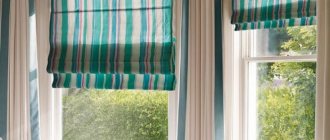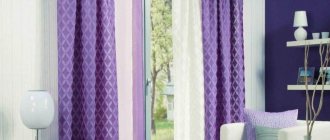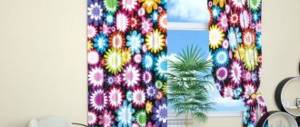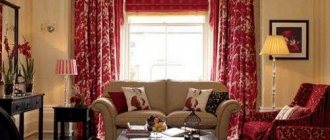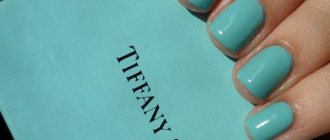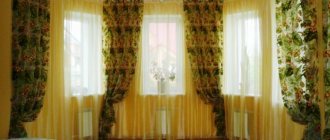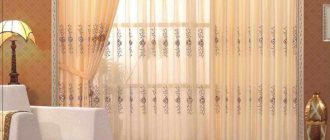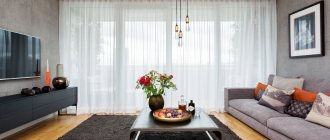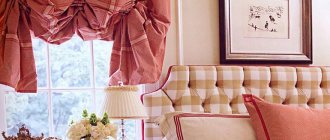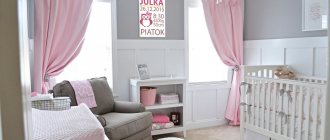The homeland of these cute and romantic curtains is one of the most beautiful and prosperous European countries - Austria, or rather its capital Vienna. Maybe that's why Austrian curtains are often called Viennese. Initially, judging by the description, they were static, made of thick satin and velvet, abundantly decorated with fringe and tassels and served as a kind of lambrequins, performing only a decorative function. Over time, the range of fabrics for sewing them became more affordable, and the design was enriched with a lifting mechanism, which made them a full-fledged and independent window decoration.
- What are Austrian curtains?
- Advantages of Austrian curtains
- What fabrics are suitable for Austrian curtains
- In what interior styles are Austrian curtains used?
- Caring for Austrian curtains
What are Austrian curtains?
Austrian lifting curtains are a symbiosis of French and Roman curtains. From the first they took festoons - semicircular, lush, but passing only along the bottom of the fold, and from the second - a lifting mechanism in the form of a cord pulled through rings and loops. When assembled, Venetian curtains resemble lambrequins with a wavy edge. When lowered, their upper part falls freely, and the lower edge remains gathered into puffs.
The curtain rods for Austrian curtains use the same lifting rods as for Roman and French curtains. They can be with manual or automatic control. The Viennese blind is attached to the rail cornice itself using adhesive tape. One part of the tape is sewn to its upper edge, and the second is attached to the profile. There are also cornices designed for bay, arched and sloping windows.
The number of festoons (buffs) varies from two or more. Austrian lifting curtains also differ in length. Basically, when the canvas is straightened, it does not fall below the window sill, but there are also floor-length models. Viennese models in the form of an arch look original and expressive, the length of which gradually increases from the center to the sides. The design of the side edges also varies. They can be:
- with fixed edges along which the curtain lifting cord runs;
- with edges hanging freely in the form of “ears”.
If desired, Austrian curtains are trimmed with lace, frills, tassels, fringe or cords. Models decorated with silk roses, made of contrasting or similar-colored fabric, or bows look very elegant and romantic.
Austrian curtains are self-sufficient in any interior and do not need partners, but exceptions are possible. For example, when the curtain is made of transparent curtain textiles, it can serve as tulle and be complemented by thick curtains.
Viennese curtains look most organic on large windows and in rooms with high ceilings, since lush festoons visually reduce the space.
What are they?
Austrian curtains are a very successful combination of Roman and French curtains in a single form, which has been around for a very long time, despite the contrast of their designs. From the famous French curtains, their Austrian counterparts have luxurious folds and pomp, and from Roman curtains they have a special mechanism and rise.
When the curtains completely cover the window, that is, they are straightened, their appearance resembles a uniform canvas, and when they are lifted, folds and gathers immediately begin to appear. When raising Austrian curtains, decorative and heavy cords are often used, which not only make them fluffy and allow folds to appear, but also serve as unique decorative elements and perfectly complement the curtains.
Articles on the topic (click to view)
- How to make folds in curtains with your own hands
- Photo of a hidden curtain rod in a suspended ceiling
- Photo of blue curtains in the living room interior
- Photo of the interior of a bedroom and living room with gray curtains
- Electric roller blinds with remote control
- How to make roller blinds for plastic windows with your own hands
- Curtains with patterns and photo printing
If it is important for you that the Austrian curtain in all its folded glory covers most of the window, make sure that when unfolded it is longer than the window sill.
Advantages of Austrian curtains
The main advantage of these models is their high decorative properties. It is also noteworthy that their somewhat old-fashioned beauty fits perfectly into most modern styles. The undoubted advantages of such structures are also:
- Easy to use: to open and close them, just pull one of the cords. There are also automatic lifting mechanisms - in this case, to raise the canvases, just press a button.
- Space-saving: when raised, they allow the use of a window sill and do not interfere with free passage to the window.
- The ability to make them yourself: to do this, you just need to select the appropriate material and assemble it into scallops using braid. Moreover, if you tie it with a bow, you can open the curtains when washing.
What fabrics are suitable for Austrian curtains
Another valuable advantage of Austrian curtains in the interior is that they can be sewn from materials of a wide variety of textures and densities. The main condition is that the textiles must drape well:
- Thick curtains made of smooth and shiny materials: taffeta, satin, silk, polyester, moire will look very impressive and festive and are suitable for the living room
- Curtains made of thin and transparent fabrics: curtains made of tulle, cambric, chiffon, veil, organza - will add notes of lightness and freshness to the atmosphere and will be appropriate in any room.
- For the kitchen, practical and elegant scalloped curtains made of cotton, linen or chintz are an ideal option.
- For the bedroom, you can sew curtains from soft velvet with short pile or jacquard: they will perfectly shade the room while you sleep.
The softer the fabric, the more voluminous and orderly (flowing freely and smoothly) the scallops will look. Light translucent material will form a light airy “cloud” over the window. Stiffer fabrics, such as chintz and cotton, are easily gathered into textured wide folds; they are most often used for sewing Austrian curtains for the kitchen.
To fully emphasize the play of light and shadows, it is better to choose plain pastel shades. A small pattern can also highlight the beauty of the scallops, but you should not use too large prints - after draping they will break into folds and lose their integrity.
Master class on sewing Austrian curtains
Anyone who has at least basic skills in using a sewing machine can sew Viennese curtains with their own hands. The most important step in sewing is the correct choice of material.
Choice of fabric and design
Austrian curtains can be made from almost any material. But in order for the model to look good and not cause trouble during operation, when choosing fabric you must adhere to the following recommendations:
- Tulle, veil, organza will make the curtain light and weightless. These translucent fabrics drape easily and well. You can complement them with classic thick curtains.
- A curtain made of brocade, thick satin, or artificial silk will look impressive and festive. Iridescent synthetic fabrics look very beautiful.
- In rooms decorated in Scandinavian style or Provence and country style, thick chintz, linen, and satin would be appropriate.
- If it is necessary to use dense, heavy fabrics, it is recommended to opt for plain soft fabrics. To create beautiful scallops, you can use wool or velvet.
When choosing fabric, great attention should be paid to the pattern . It should not be too flashy or small. A large pattern on the drapery will not be visible and its effect will be blurry.
You can decorate Austrian curtains with a fluffy bottom edge with your own hands:
- lace;
- braid;
- fringe;
- waves;
- ruffles;
- with brushes.
To adjust the length of the canvas, cords or special curtain tape .
After choosing the material, you need to decide on its quantity:
- The width of the canvas should be 2–2.5 times the length of the cornice.
- The length of the curtain depends on the intended design. Therefore, it is taken one and a half times the distance from the cornice to the desired lower point.
You can also make a cornice with your own hands from a wooden strip along the width of the window opening and screws with rings. The strip will need to be sewn into the upper edge of the canvas and secured above the window opening with screws.
Necessary materials
In addition to a sewing machine, to sew Austrian curtains with your own hands you will need:
- threads, needles and scissors;
- main fabric;
- iron;
- pins;
- chalk;
- ruler;
- cord or curtain tape;
- additional elements in the form of brushes, ribbons, cords, etc.;
- if necessary, weights.
Step-by-step instruction
Before starting to cut out the parts, it is recommended to steam the fabric . This is necessary so that the first wash does not spoil the appearance of the curtains.
Sewing steps:
- Cut a piece of fabric to the desired size. In this case, 6 cm should be left for the lower edges for folding, and 3 cm for side hems.
- Mark with chalk the places where the curtain tape will go. To do this, you can use a previously prepared pattern.
- Topstitch the side hem.
- Using a basting stitch, manually sew the ribbon strips to the marked places. Along the edges they are hemmed as close to the hem as possible.
- The canvas is ironed, and the braid is attached to the curtain with a machine. The upper part of the Austrian curtain is flat, so the braid is not sewn along its entire length.
- At the top of the product, the fabric is turned inside out by 5 cm and sewn with threads in the color of the fabric.
- A wide ribbon is sewn along the seam on the front side for hanging. Its standard width is 6 cm.
- The tape is turned inside out and attached again. From the front side only a neat, even seam will be visible.
- The bottom edge is processed with a double hem and is shaped depending on the idea. Various decorative elements can be sewn to it.
- After each stitched line, it is recommended to iron the fabric with an iron. Heat treatment will make the product look neat, and unnecessary folds will not accumulate on it.
On the finished English curtain, the braid is carefully tightened and the cords are fixed . It is necessary to achieve the desired density of folds. At the bottom of each tape you can sew weights that will weigh down the curtains. Curtains with weights will hang more evenly and look aesthetically pleasing.
If there is no special curtain tape, then to create a drapery you can use ordinary braid, sewing plastic rings of small diameter to it in increments of 12 cm.
Assembling the curtain will be greatly facilitated by a special lifting mechanism. It comes out from the side of the canvas and is attached to the top of the cords.
In what interior styles are Austrian curtains used?
Scalloped curtains are designed to emphasize the beauty, grace and softness of the environment. Therefore, when creating a minimalist design (high-tech, techno, loft), Austrian curtains will look out of place in the interior. But they will be an ideal option for rooms decorated in classical, Victorian, Gregorian, as well as Baroque and Rococo, Renaissance or Empire styles. And due to the fact that these curtains, unlike their French counterparts, are not so pompous, they are ideal for such democratic designs as country, Provence and Mediterranean.
In rooms with large windows, it is better to use “Austrian” in a classic design, with the maximum number of festoons collected in the lower part of the canvases. Translucent Austrian curtains in the interior will emphasize lightness and elegance; heavier ones will make it more luxurious.
For decor in the Mediterranean style, as well as country and Provence styles, it is better to take light cotton, chintz, satin or their mixed versions with floral prints. Lush lambrequins and other elaborate elements are not used in this case - only light and delicate lace is allowed.
For the kitchen, you should choose light textiles that only partially obscure the light. And it will be easier to care for such curtains. For reasons of convenience, it is better to adjust their length to the level of the middle of the window or window sill.
Curtains made of thick fabrics - silk, velvet or jacquard, which do not let in sunlight, will give the bedroom a cozy and intimate atmosphere. Excessive solemnity and pomp here will be unnecessary, so the number of festoons and their depth can be reduced. In girls' rooms, medium-density scallop curtains decorated with bows and frills also look good.
Office spaces are also decorated with Viennese curtains. Calm colors are selected for them, harmoniously combined with furniture upholstery and wall decoration. Such curtains are used with a minimum of decor - the main emphasis is on the richness and beauty of the material.
Window decor in a classic style
The rigor, sophistication, sublimity and special beauty of the decor inherent in the classics, as well as some modern related styles, allow wavy volumetric curtains to look organically in the interior. They decorate both miniature and large windows. They can be placed across the entire width of the wall or built directly into window openings.
When choosing fabric for sewing products in a classic style, give preference to dense, soft textiles in rich dark shades. Exquisite moire or thick silk, pompous velvet or strong jacquard are suitable. When sewing products for a modern interior, choose weightless fabrics, such as chiffon, light silk or voile. A canvas with a classic ornament or a geometric pattern will look beautiful.
How do Austrian curtains look in the interior of rooms?
- 1 Presentable in the office. For the design of a business office, an exclusively strict classical form of products is acceptable, without the use of additional decor (tassels, ribbons, bows, etc.). For a productive working mood, use textiles in dark, soft colors. It should emphasize the presentability of the furniture and harmoniously combine with the decoration of the room.
- 2Solemnly in the restaurant. Quite often, restaurant halls are decorated with voluminous and stylish Austrian curtains. Combined with the color scheme of the interior, they give it solemnity, festivity or special romance, depending on the cut of the fabric. Designers use textiles of different densities to decorate banquet halls, skillfully combining them. For example, thick satin or moire will create a secluded atmosphere for a romantic date or confidential meeting, while a light veil will promote openness and sociability at a corporate event.
- 3Luxurious in the living room. Austrian curtains also look great in living spaces with a large area. They look very impressive on the windows of the living room, associating with the luxury of ballrooms. They give the room some festiveness and sublimity. To emphasize the richness of cut and fabric, products are often combined with other textile window decorations, creating interesting ensemble solutions.
- 4 Romantic in the bedroom. To create a bedroom interior with a romantic and dreamy atmosphere, use dense fabric in pastel shades, or soft dark tones, in harmony with other textiles or the background of the room. Transparent flowing curtains will be a good addition; they will add coziness and emphasize the secluded atmosphere of the bedroom.
- 5 Practical in the kitchen. Austrian curtains up to the window sill are also used in the kitchen. They go well with natural wood furniture in a classic style. For Austrian curtains in the kitchen, it is better to choose a practical fabric on which dirt will not be too noticeable and which will not lose its appearance due to frequent washing. Synthetics absorb odor less, making them more convenient for use in the kitchen.
- 6 Gently in the nursery. Lush window decor will look appropriate in a girl’s bedroom. A room for a little lady will be gentle and elegant if you choose fabric in light colors - lilac, white, peach, light green. In this case, you can use various ruffles and bows without fear; they are quite suitable for a princess’s room. For a child's room, it is necessary to consider the possibility of adjusting the lighting. This is easy to achieve due to the lifting mechanism and a combination of fabrics of different densities.
Caring for Austrian curtains
To remove the fabric from the curtain rod, the lifting cords are first removed from the rings, and then the Velcro is unfastened. Washing is done by hand or on a delicate cycle. Before washing, curtains are placed in special bags.
It is convenient to clean heavy textiles from time to time, removing dust from the folds, using a vacuum cleaner with a special attachment. Fabrics that require special “dry” treatment, for example, velvet, are best taken to dry cleaning. Wool and natural silk products do not tolerate moisture well. Fringe, glass beads, soutache and other types of trim that may be damaged during washing are first stripped off.
Veil and organza are washed in lukewarm water at a temperature of up to 30 °C without spinning. Recommended mode: hand wash. High-quality organza does not need to be ironed.

